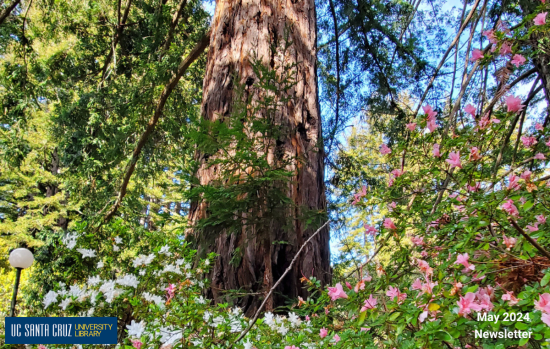
News from University Librarian Elizabeth Cowell
Exploring the Treasures: New Students Embark on a Journey through Special Collections & Archives
Tripping on Utopia in the Archives
Community Voices Series event remembers Santa Cruz's fourth Chinatown
Welcome to Sam Regal, Special Collections & Archives’ new Instructions & Exhibitions Librarian
News from University Librarian Elizabeth Cowell
Dear Friends,
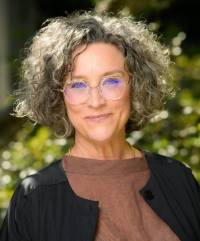
This quarter, I wanted to highlight an instrumental group at the Library, Special Collections & Archives (SC&A). From rare manuscripts to historical documents, from unique artist books to personal papers of renowned individuals, Special Collections & Archives offers a window into the cultural, social, and intellectual tapestry of UCSC. In this newsletter, I hope to draw your attention to the valuable contributions they make to scholarship, education, and the preservation of our collective heritage. Join me as I delve into the fascinating realms of history, culture, and discovery awaiting within our Special Collections & Archives .
A guiding goal of SC&A is to facilitate broad access to the Library's most rare and unique resources. In light of this, archivists recently took advantage of remote working arrangements to publish new descriptions of archival collections so that students and the general public can more easily discover materials online. In fact, our archivists have processed over 60 linear feet of archival material and published seven new archival collection guides in the first quarter of 2024 alone! SC&A has developed innovative project management infrastructure to support ongoing maintenance of the Library's Digital Collections and archival description on the Online Archive of California.
SC&A is embarking on an innovative long-term effort to preserve a large quantity of the Library's analog audiovisual media holdings. From mid-century audio recordings of the anthropologist Gregory Bateson to video footage of student life in the 1980s, this unique content forms a vital part of the world's cultural heritage. SC&A is finding many ways to streamline its processes for the preservation and access to special formats like media and digital archives. The diverse work and accomplishments of SC&A is underpinned by the Library's commitment to providing inclusive access to our resources.
SC&A invites students and community members to not only explore the riches within our archives but also to actively engage with them, to ask questions, to challenge assumptions, and to seek out the untold stories that lie hidden beneath the surface. For this reason, I am thrilled to welcome our newest colleague in Special Collections, Sam Regal. Sam is the Instructions & Exhibitions Librarian, a role critical to the SC&A’s outreach to the campus community. This past winter quarter, over 150 students were welcomed into the Special Collections Reading Room by the University Archivist as part of the Winter Core Course.
And have you heard about the Elisabeth Remak-Honnef Center for Archival Research and Training (CART)? Housed within Special Collections & Archives, CART is a program for graduate students to develop their archival research skills to support their career success and increase access to unique Library resources. Our CART fellow has worked hard this year. I hope you will visit their end-of-year exhibition, which will feature CART fellow, Meleia Simon-Reynolds’ work on the Nina Graboi papers and the records of the Watsonville-Santa Cruz Chapter of the Japanese American Citizens League (JACL). You can also read about a CART event that was held in February featuring History professor Ben Breen and his newly published book, Tripping on Utopia: Margaret Mead, the Cold War, and the Troubled Birth of Psychedelic Science.
Special Collections & Archives at the University Library is also home to our Community Archivist, Rebecca Hernandez. Rebecca is charged with seeking out partnerships with community organizations and leaders to support the preservation of community history, with a particular focus on reaching out to traditionally underrepresented communities. Rebecca works closely with numerous partners, including Watsonville is in the Heart, a community archive and research initiative on campus, and served as an advisor to the recently opened exhibition, Sowing Seeds: Filipino American Stories from the Pajaro Valley at the Santa Cruz Museum of Art & History (co-curated by former CART fellow Christina Ayson Plank and current CART fellow Simon-Reynolds). You can read more about Rebecca’s work with community member George Ow and the Community Voices event series, below.
We hope you thoroughly enjoy perusing the latest edition of our newsletter and engaging with the ongoing activities and exhibitions here at the University library.
Elizabeth
Exploring the Treasures: New Students Embark on a Journey through Special Collections & Archives
By Kelsey Knox, University Archivist
In the first four weeks of Winter Quarter at UC Santa Cruz, Special Collections & Archives welcomed over 150 winter admit students into the Special Collections Reading Room to complete an
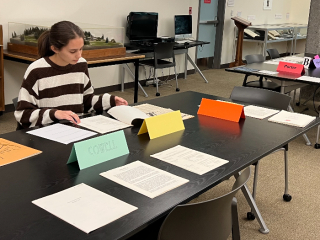
assignment for College 1, the foundational course required for all new students at UCSC. This “core course” is meant to connect new students with the theme of their college. Usually, students would take this class during the fall quarter, with other students from their college. However, this winter quarter students were instead mixed with other students from across the ten colleges with a broader theme for the class of "Individual, University, and Society."
All students enrolled in College 1 were tasked with visiting Special Collections and completing a worksheet that was created by myself, the University Archivist. The goal of the Special Collections assignment was to not only familiarize new students with Special Collections as a resource that is available to them, but also to help them connect with the theme of their residential college by working with historical archival materials that reflect the themes of those colleges at the times of their founding.
Students explored curated materials such as early college handbooks, newspaper articles about the founding and dedication of their college, correspondence between college administrators regarding potential college themes, and scrapbooks. They were then asked such questions as, “Around when was your college founded?” and “Based on what materials you viewed and what you know about your college today, has your college theme or mission changed? How?” Special Collections student workers and staff were on hand to answer questions and make sure the assignment ran smoothly. We hope these students will continue to utilize Special Collections & Archives throughout their time at UCSC!
Tripping on Utopia in the Archives
By Meleia Simon-Reynolds, CART Fellow and Alix Norton, Center for Archival Research and Training (CART) Archivist
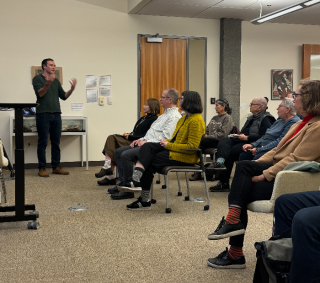
In early February, the Elisabeth Remak-Honnef Center for Archival Research and Training (CART) hosted History professor Ben Breen for a discussion of his newly published book, Tripping on Utopia: Margaret Mead, the Cold War, and the Troubled Birth of Psychedelic Science. At UC Santa Cruz, Breen’s research includes the histories of the Portuguese, Spanish, and British empires, as well as the history of science, medicine, globalization, and the impacts of technological change. His newest book explores the early days of psychedelic science in the twentieth century.
In the course of his research for Tripping on Utopia, Professor Breen utilized several sources from the University Library’s Special Collections & Archives, including the Gregory Bateson Papers, the Robert A. and Virginia G. Heinlein Papers, and the Nina Graboi Papers. Graboi was a Santa Cruz local who was interested in psychedelics and worked with the likes of Ram Dass and Timothy Leary. Her papers were donated to Special Collections, much to the delight of researchers like Breen, and of graduate students interested in archival research like Meleia Simon-Reynolds.
Meleia Simon-Reynolds is the 2023-2024 graduate fellow in the Center for Archival Research and Training. Her research focuses on twentieth century Filipino American history in Watsonville, Santa Cruz county, and the broader region of California’s central coast. As someone who is passionate about local history and community-engaged research, Meleia was excited to organize and describe Nina Graboi’s papers as part of her work in CART. Graboi was born on December 8, 1918 in Vienna, Austria. She fled Vienna in 1938 and eventually immigrated to the United States in 1941. From the 1960s through the 1990s, Graboi wrote extensively about her experiences taking psychedelic drugs and her spiritual beliefs. In 1991, her autobiography, One Foot in the Future: A Woman's Spiritual Journey, was published. Graboi passed away in 1999 at her home in Santa Cruz. Her papers were donated to Special Collections & Archives in 2003. Meleia was primarily familiar with larger-than-life male figures in the counterculture and psychedelic science movements; happily, working with Graboi’s records provided her with a woman’s perspective on these histories. She particularly enjoyed learning about Graboi’s experiences participating in events pertaining to psychedelics and spirituality in Santa Cruz and on the UCSC campus. Presently, Meleia is learning about another side of Santa Cruz county history through her work processing the Watsonville-Santa Cruz Japanese American Citizens League records and making them available for research.
The February event included a presentation by Professor Breen on the subjects of his book, the research he conducted at UC Santa Cruz, and archival encounters with materials from the collections of Bateson, Heinlein, Graboi, among others. A diverse group of approximately forty faculty, graduate and undergraduate students, community members, and researchers filled the reading room. They engaged in lively discussion with Breen about his research topics and the primary sources he consulted for his book. After the presentation, attendees looked through boxes of archival material from the Bateson, Heinlein, and Graboi collections and engaged in dialogue with Breen, talking through some of his lingering questions and points of analysis.
We’re excited to host more events like this in the future, highlighting the research of the UCSC community and providing opportunities for archival encounters with the collections in our care. Stay tuned for more—you can learn more about the Center for Archival Research and Training by visiting the CART website and joining the mailing list.
Community Voices Series event remembers Santa Cruz's fourth Chinatown
By Grace Stetson
While walking along the San Lorenzo Riverfront off River Street and Soquel Avenue, visitors and locals alike will come across a seemingly out-of-place, but beautifully decorated and stationed passageway. A mosaic-adorned red and gold dragon, measuring nearly 21 feet, appears to welcome us to come up, explore, and learn more about how it fits into the city’s history.
Installed in November 2020 by the Coastal Watershed Commission with the support of the City of Santa Cruz, the Patagonia Foundation, and the Ows, a local philanthropic family, the Santa Cruz Chinatown Memorial Archway symbolizes an important, albeit long forgotten, group of Santa Cruzans from years past.
Local developer George Ow Jr., who with his family shepherded the dragon into existence, remembers the city’s Chinatown fondly. In fact, it was where he grew up in the city of Santa Cruz, from 1943 to 1955, back when Santa Cruz’s Chinatown existed near the archway’s current location.
“This area feels like home to me, I feel very comfortable here,” Ow said, acknowledging the large expanse of the city’s current downtown.
On Thursday, February 15, Ow took to the stage at the Santa Cruz Museum of Art & History, sharing personal stories of growing up in Santa Cruz’s fourth Chinatown and how it shaped his perspective
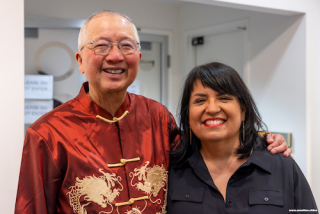
of the city into the present. The free 90-minute event was packed, with approximately 200 attendees standing throughout the museum space including along the staircase, to hear Ow’s story and his conversation with UC Santa Cruz’s own University Library Community Archivist Rebecca Hernandez.
The event was the second in a newly established annual series, headed by Hernandez, called the Community Voices Series. Since taking on the role in January 2022, Hernandez has diligently worked with local community groups and individuals alike to share their oft-overlooked histories in the area.
“The basis of what I do is to encourage people to think about the value of their history and their community’s history, and consider how we can preserve it,” Hernandez said. “The absence of those stories means we might never know about the contributions of individuals and community groups, whose hard work made it possible for us to enjoy what they never could.”
Ow’s Life in Chinatown
Ow was born in Santa Cruz in 1943, in the city’s Chinatown that was located just across the San Lorenzo River, near the county office building off of Ocean and Water streets. This location was the city’s fourth iteration of Chinatown, established in 1894 and dismantled in 1955. But, for the first 12 years of Ow’s life, he ingratiated himself in the community, and found a great deal of joy from his upbringing in Santa Cruz.
His father, George Ow Sr., had arrived in Santa Cruz to live with his uncle, who owned and operated the Canton Market supermarket at the corner of Cathcart Street and Pacific Avenue. That was the process for many members of the Ow family to arrive in Santa Cruz, Ow shared, with one person offering another a business opportunity and housing. It led to a large swath of Chinese immigrants arriving to the city, and raising first- and second-generation children and grandchildren to carry on in the family’s name.
“Santa Cruz was a ghetto, but I didn’t know it. I thought it was the greatest place because my aunts and my uncles, and my grandparents, were here,” Ow said. “I thought it was just a place full of love — this was a great area to grow up.”
And from his upbringing, it sounded like Santa Cruz was entirely full of love. Ow was one of seven children, but his parents — who graduated from Santa Cruz High School in 1940 and 1942, respectfully — never denied them love, adoration, and bonding.
“I'm so happy that this is where they ended up, because they had a head start,” Ow said. “They bought land, and what a heck of a difference that makes for us to stay here.”
Sharing historical realities in the present
As Ow entered adulthood, he moved around and away from Santa Cruz — attending school at Monterey Peninsula College and UCLA, then entering the draft and heading to Vietnam — before returning to his long-time home. Since returning to Santa Cruz, Ow has delved more into learning about his past, and worked with locally based historians to garner more information about his family and that of the city’s Chinatown.
On Thursday, Ow gave a special shout-out to two Santa Cruz based historians who have helped to further uncover much of his family’s history, Geoffrey Dunn and Sandy Lydon, and released books such as Santa Cruz Is In The Heart, Chinatown Dreams, and Chinese Gold to elaborate on those histories.
One of his continued favorite aspects of Santa Cruz is returning to the San Lorenzo Riverbed in the summers, and seeing all of the mosaic tiles that local artist and retired teacher Kathleen Crocetti and her Mission High Middle School students have installed throughout the area. Crocetti was also the primary artist behind the 21-foot dragon above the Chinatown Memorial Archway back in 2020.
Gail Michaelis-Ow, Ow’s wife of nearly 45 years, shared that one of her husband’s top passions is history and the history of his own family: “He’s spoken in different places and in front of a lot of different classes, including at Cabrillo and UCSC, but this was certainly the largest venue that I remember.”
As she said, event attendees were excited to hear about his family’s history and that it meant a lot to him. Based on the support and encouragement from Thursday’s event, Michelis-Ow said that Ow would be interested in sharing more about his background to additional groups in the future.
Ow is grateful to other Santa Cruzans like Crocetti, Dunn, and Lydon for their continued work to remember his heritage and past.
“There wouldn’t be the history without them — it would be lost,” Ow affirmed. “What they’ve done for somebody Chinese like me, it’s given me a lot of pride, and showed so much that was unknown.”
The February event was further supported by the UCSC Asian-American/Pacific Islander Resource Center, Santa Cruz-based nonprofit Flex Kids Culture, and staff from the Santa Cruz Museum of Art & History. The event was recorded and will be made available on the UCSC Special Collections & Archives Community Archiving Program webpage in the coming months.
Welcome to Sam Regal, Special Collections & Archives’ new Instructions & Exhibitions Librarian
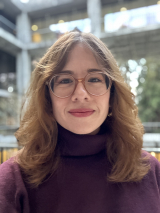
Sam joined the SC&A team in January, coming to us from the California Institute of the Arts where she served as Reference and Instruction Librarian. She is an alum of the UCLA MLIS program and has also worked for California Rare Book School. She is a gifted instructor who has already made connections with a number of new faculty, hosting over 250 students in Special Collections in her first quarter at UCSC. In addition to her instruction duties, Sam leads programming and exhibition efforts for Special Collections & Archives.
Before coming to UC Santa Cruz, Sam served as the Reference and Instruction Librarian at the California Institute of the Arts in Los Angeles. She received her MLIS from UCLA in 2022 and holds her MFA in Poetry from the City University of New York. Her role in Special Collections is to coordinate exhibitions, instruction, programming, and reference for UCSC Library’s Special Collections & Archives. She is very involved in student programming and will also curate the Grateful Dead Archive rotating exhibition.
Unveiling Disneyland's Hidden Heroines: Special Collections & Archives Presents 'The Women Who Made Early Disneyland’ with coauthors Kelsey Knox (UCSC University Archivist) and Cindy Mediavilla
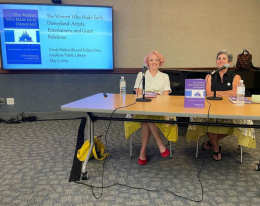
What began in 2019 as plans to research and write an article about Ruth Shellhorn—a female landscape architect who designed much of Disneyland's lush landscapes ahead of the park's opening in
1955—ballooned into a nearly 300-page book about more than 20 women who had a hand in the design and creation of Disneyland in the first ten years of the park's existence. The Women Who Made Early Disneyland: Artists, Entertainers, and Guest Relations dives into the lives and careers of female artists, costume designers, performers, and more who have been mostly overlooked by Disney historians. This true labor of love, researched and written by Cindy Mediavilla and UCSC University Archivist Kelsey Knox, is now published by Lexington Books, the academic imprint of Rowman and Littlefield, as part of its series, "Studies in Disney and Culture."
Special Collections & Archives at UCSC invites you to celebrate the publication of The Women Who Made Early Disneyland with coauthors Kelsey Knox (UCSC University Archivist) and Cindy Mediavilla on Tuesday, July 23, from 5 to 6:30 p.m. in McHenry Library, Special Collections & Archives.
If the University Library holds a special place in your heart,
and you value the countless ways it enriches our campus community and extends its impact beyond; we kindly invite you to make a gift to support our ongoing efforts.
Credits
Contributors: Elizabeth Cowell, Liz White, Kelsey Knox, Sam Regal, Meleia Simon-Reynolds, Alix Norton and Grace Stetson
Production: Linda Hunt
Copyediting: Greg Careaga
Photography: Carolyn Lagattuta, Joop Rubens, Linda Hunt, Krystyn Slack and Andrew O'Keefe


 Santa Cruz, CA
Santa Cruz, CA



